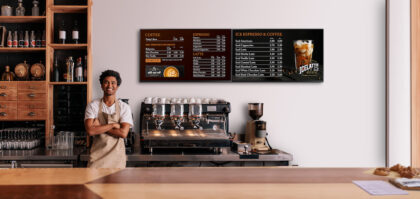Vibrant colors and vivid imagery are what everyone sees and remembers on a display — but the real magic happens behind the scenes, in the content management system (CMS). The sophisticated software puts the correct information on screens in the most suitable places, at the right times and with eye-catching design. For managers, a high-quality CMS also makes workflows intuitive and efficient while ensuring updates are easy.
Samsung has developed and refined its digital signage software solution since 2008. Known as Samsung VXT, this CMS is a solid, sophisticated and stable option for businesses of all sizes worried about the long-term health of independent software companies — particularly in uncertain economic climates. Using the solutions created by a large, stable organization can have significant benefits when entering long-term business relationships.
Risk-free content management
Samsung signage software also provides greater peace of mind in terms of security, which is increasingly important as data breaches on display CMS solutions or devices by hackers increase. Because even one successful hack can significantly harm a brand’s image and operations, Samsung purposefully sought ISO 27001 and ISO 27701 certifications to provide the highest level of security for its TV content management system.
Samsung VXT also uses a two-level organizational structure — Organization and Workplace — that protects content systematically from technical breaches while enabling businesses to operate more flexibly. This allows managers to create separate workplace areas with different authorizations, effectively blocking users from accessing data they are not permitted to.
Elevate your QSR by empowering employees
Explore how key technologies can help QSRs stay competitive and mitigate growing industry problems. Download Now
Keys to CMS success
There are three key elements to the VXT solution: Author, Server and Player.
Author your own story
VXT Author is the software toolset used directly by end users or their contracted service providers to create content that’s scheduled and pushed to displays. Author includes an extensive library of predesigned, business-ready templates, icons and images, making it easy for operators of any size to quickly develop material for screens without needing outside creative help.
The software also includes a set of pre-scripted widgets that automate content, such as ZIP code-specific weather conditions and forecasts. Author is also optimized to support third-party creative in various formats — from HD images and videos to Photoshop files and Microsoft 365 documents.
A server for all needs
Think of VXT Server as the hub of a digital signage network — the toolset used to target, schedule and push content to 1, 100, 1,000 or more players and screens.
With Server, each piece of media, screen and location can be data-tagged with its key characteristics. You can use this data to quickly schedule a piece of content to appear only in specific, relevant locations. On a basic digital signage CMS, this would be a huge chore. But using Server, it’s primarily automated by that data-matching capability. Server also contains all of VXT’s robust device management tools, which are unique to Samsung and among the most important features of an effective digital signage CMS.
Server’s monitoring dashboard provides users a real-time overview of the status of each device deployed in a network, as well as stats and data analysis, showing trends and warning you of any developing issues, such as unreliable connectivity. This minimizes outages, maximizes screen uptimes and dramatically reduces the number of costly on-site field service calls. With the right remote management and troubleshooting tools, rolling a truck to off-site locations becomes the exception instead of an expensive rule.
From controlling display content and accessing hardware settings to troubleshooting issues, VXT allows users to remotely manage both the content and the device on a single platform. Server can also deploy up to 10 scheduled multichannels, allowing users to create multiple frames within a single display panel with unique content. If an error is detected, Server’s multiscreen remote control allows users to view and interact with multiple screens, making diagnosing the issue much more straightforward.
The all-star player
Samsung has long been the market leader and innovator of smart displays embedded with System-on-Chip (SoC) technology. Instead of relying on external media players — which add costs and complications — SoC-based displays have computing and graphics components built right in.
VXT Player is designed specifically for Samsung smart SoC displays optimized for the hardware. Most third-party CMS software platforms were written for external media playback devices like PCs and commercial set-top boxes and then adapted for smart displays. VXT Player handles smooth play-out of scheduled media files, logs activity and steadily checks back in with Server to provide analytics and pick up new instructions and media files. VXT Player is also compatible with multiple web formats and standards.
Matched sets
There’s a reason consumers buy matched sets for everything from power tools to cookware to electronics: Matched items share engineering DNA and work well together. Samsung VXT is a great example. The mature, matched-set technology platform proprietary to Samsung hardware and software solutions is suited to any job and optimized for the smart displays that now dominate the digital signage marketplace. To learn more about VXT and get started today, visit vxt.samsung.com.
Sign up for a VXT free trial here. And find out more about how SoC technology advances management of digital signage.








